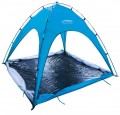Weight
The total weight of the tent is including the frame and other accessories.
This parameter depends primarily on the purpose (see above), and after that — on seasonality, capacity, and additional functions. For example, in trekking and expedition models, the weight usually does not exceed
5 – 7.5 kg, and the lightest of these products can weigh
2 – 3 kg or even
less, while being full-fledged tents for 2 people or even more. However, for a trekking tent, such a small weight with a capacity of more than 2 people usually means that this model is designed exclusively for the summer. For most camping tents, the weight starts at 6 kg, although among them there are also quite light products — by
4 – 5 kg,
3 – 4 kg, or even less (in such cases, light weight can also mean a purely summer specialization). And the most capacious and/or multifunctional models can have a weight of
10 – 15 kg,
15 – 20 kg and even
more; in this weight category, you can mainly find tents, camping tents for many people and fishing tents for carp fishing (see "Destination").
When choosing a tent according to this indicator, it is worth considering that it does not always make sense to chase the maximum weight reduction. Yes, the
...light tent is the most convenient to carry; on the other hand, weight reduction inevitably affects one or several other characteristics at once. So, most often, lighter models are either more expensive or smaller in size and less roomy and functional than their heavier counterparts. And sometimes weight reduction also negatively affects the security (including moisture resistance) and the overall reliability of the product. Therefore, it makes sense to specifically look for the lightest tent possible in cases where weight reduction is of key importance; a typical example is long trips, in which all the equipment has to be carried “on oneself” for a long time. And even in such cases, it is worth remembering other important characteristics. For example, for use in late autumn, when frosts are likely, it is better to choose a heavier tent with winter seasonality than a light model that is not designed for winter conditions.Number of entrances
This item refers to the total number of entrances to the tent. In most cases, their number also describes the possibility of entering the sleeping area. However, there are models with a large vestibule, in which the input is provided from different sides. Such abundant entry/exit options allow you to use the tent in various situations. For example, focusing on the position of the sun, it will be relevant to open the western or eastern side; landscape conditions will not interfere with the installation of the tent, since one of the exits will remain accessible in any case. Well, for a large company at a campsite, vacationers will not interfere with each other.
Frame material
The material from which the frame of the tent (arc) is made. The main requirements for arcs are strength, resistance to deformation (elasticity) and low weight. Modern tents use several materials with different ratios of these parameters.
—
Aluminium. A fairly common material: it has good strength characteristics and low weight, but it is relatively inexpensive. At the same time, aluminium is prone to deformation under long-term stress (although this is usually not critical even when parking for several days).
—
Fibreglass. Composite material based on a combination of fibreglass and plastic. The main advantage of fibreglass is resistance to deformation: even under prolonged loads, the arcs do not lose their shape. In addition, this material is cheap and light in weight (although somewhat heavier than aluminium). The disadvantage of fibreglass is its sensitivity to low temperatures, which limits its use in winter conditions and at high mountains. However, most people use tents in the warm season, and therefore fibreglass has recently gained considerable popularity.
—
Steel. Steel is the most durable of the described materials, in addition, it holds loads well, almost without deforming. At the same time, steel arcs have a significant weight, and therefore they are rarely used in tents.
— Durapol. A composite material that has appe
...ared relatively recently and is positioned as a more advanced alternative to fibreglass. Durapol has a "puff" design: the outer layer is made of special polymer resins, metal foil is located under it, a synthetic mesh is located under it, and, finally, a layer of fibreglass. According to the creators, arcs made of this material are more durable and resistant to fracture than fibreglass, better tolerate low and high temperatures, as well as ultraviolet radiation, are less susceptible to residual deformations and have less weight.
